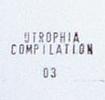Wednesday, April 19, 2006
Saturday, April 01, 2006
As we head towards the home straight..
So the record's nearly finished. This week i've been working on the opener 'Grace and Sophie', a sort of sound collage with live instruments, and bar percussion that's all wrapped up. Aside from this there are just a few drum tracks, little bits of percussion and a cello and a viola part left to record, all of which i'll be getting down to over the next few weeks. Then i have to mix it of course, but that should be a lot of fun.
It's been almost a year since i scrapped the first draft of the record and started afresh, and it feels good to be getting to this point at last, so i thought i'd share some pictures and info on the recordings my co-conspirators and i have made.
For the some large part this record is a track-by-track orchestra, featuring a wide variety of instruments and sounds. Part of the amount of time that it's taken has been because i didn't want to use samples, i wanted it to be 'real', and this lead me onto a great love for the quirks and oddities that come out of these instruments, mistakes if you like, human error, 'noise', just really good sound: the sound of a cello mis-bowed, a trombone played by someone who's never played one before, piano strings played with a plectrum, the rumbling sound an oven makes when you play bass into it, playing the keys of a flute through a distortion pedal, it's all here. I also got into bowing everything, cymbals, eggcups, a wok, glockenspiels, biscuit tin lids, mandolin, acoustic bass guitar ..anything with an edge.
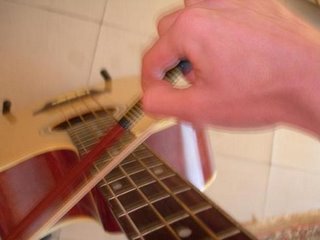
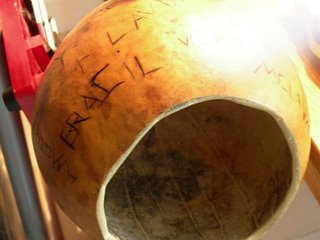
I've had a few very dear helpers for this record. Fiona Stewart on her short trips into the country has laid down some wonderful violin parts (i also played one or two myself, though incredibly naively); Tam Bo Grace has put down cello, trombone, trumpet and flute and assisted with engineering on occasion ..sometimes it's great just to have someone around to press record, play and rewind; Ross Parfitt played some saxophone and bowed cymbals. Richard Davis, Attab Haddad and Velella Velella's Andrew all put down some parts (melodica, oud/cahon and vibraphone respectively) for four tunes that didn't make this record (expect an EP or two with these at some point). There will be three others as well, the cellist, viola player and drummer, but more on those sessions after they occur. Needless to say, i'm very grateful for everybody's contributions.
Some of the parts others (and myself) laid down were scored, but for others i directed improvisations while the 'tape' rolled. We'd do take after take until either i felt we had more than enough, the computer started to get glitchy or the player simply begged for mercy (i begged for my own mercy a number of times). After the improvisations were all recorded and the musicians on their train rides home i'd sit for hours editing through the parts and compiling final violin, cello, whatever, tracks. A hell of a lot of work, but with some really great results.

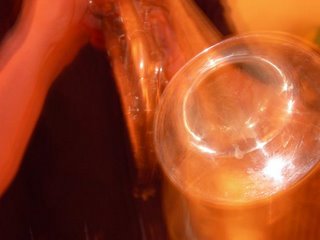
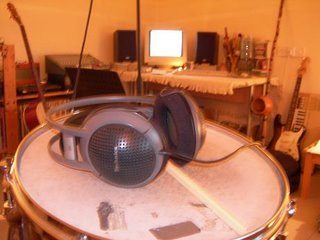
Part of working this way is that as the 'composer' you also still get to be a listener. You don't know every part off by heart, there are still surprises, especially in the deeper parts of the recordings. With scores, by the time it's recorded you know the piece all too well, and i find that a little disconcerting, it's as if it's old to you before you get to hear it.
Since before the first draft i'd been recording found sounds on my MD recorder and this intensified, for a while there i rarely went out without a little stereo mic clipped to my shirt. Some of the things i found to record in London and Amsterdam were truly inspiring, there's nothing that makes you really hear the things around you as when you're recording them. Walking down the long roads alongside the canels i was acutely aware of the wide stereo picture i was getting in my ears (and to 'tape'). Of course, Amsterdam sounds amazing with it's canels and long strips of tall thin buildings, the sound reflects beautifully, you get a great sense of space and depth. The tall buildings also keep out the traffic noise of the surrounding roads, one of the things i'd had problems with in London was isolating found sounds from the background hum of cars and motorbikes. Even in the middle of our local dense park the traffic from the roads around a mile away prevented recording isolated sounds.
Natural reverb also played a big part. The bowed cymbal recordings for instance were recorded out in the stairwell of our flats, a deep concrete and glass construction with a tiled floor that has an amazing sound to it. There was the occasion where a neighbour shouted up 'stop making that noise' at the end of a kazoo part out in the stairwell, but actually that was the only complaint i had about using the space to record. There are a lot of such recordings on the record.
Part of what i set out to do with all of this was to interest myself in the recording process, to keep it fresh and interesting, sometimes this meant taking the long road to achieve sounds, and the natural reverb was part of that. It also helped to put other things in context in the mix, recording parts with natural reverb gives you a backbone for the mix where other parts that were recorded dry can be matched to fit with those recorded wet. Similarly on a few parts i'd mic up the instrument and connect that mic to a guitar amp, and then record the sound of the room, with the clarinet (for example) nearer the mic and the sound from the amp providing background ambience. My kitchen got used a fair bit for that.
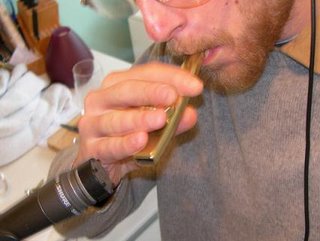
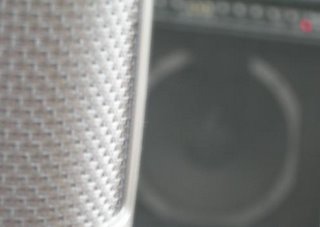
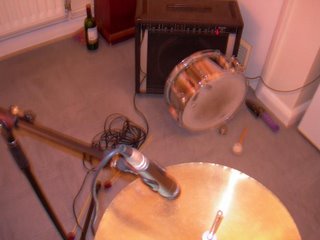
It was while recording in the kitchen that i noticed how things rattled and rumbled with bass frequencies in there, and one afternoon set about surrounding an amp with things that would rattle and shake and rumble and playing bass through the amp, creating some great ambient drones, used on both 'Grace and Sophie' and another tune that didn't make the record, 'In the Arms of a Southern Belle'.
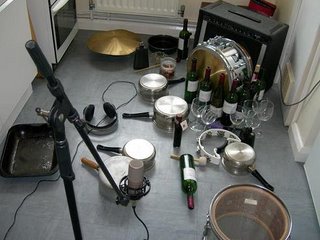

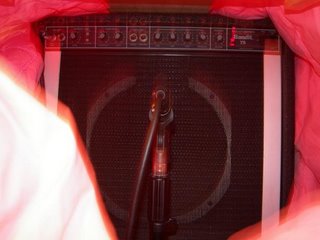
Of course, rattle and room sound isn't always something you want, on some of the bass tracks to achieve a dry but not DI'd sound i used a 'duvet tunnel' to restrict the amount of room getting into the mic. This also works nicely with kick drums. The amp or kick goes at one end of the tunnel, with a chair or stool at the other with a piece of wood (i use an old shelf) between them and a duvet or two hanging over the top. I've used an ironing board as the shelf before and that's worked nicely too, and you don't need a stool at the other end.
Towards the end of recording my interest in dub re-emerged. It's more the process of dub that interests me over the sound. I like dub a lot musically, but i'm not really interested in recreating that sound with those rhythms for my own music (not right now anyway). The technique for making dub originally was to have all of your tracks on your mixer and a bunch of effects attached to the auxes. The returning sound from the effects (delay etc) comes back in through two other channels and you can also EQ or effect those. Then you play with the auxes on each channel, 'grabbing' a bit of that vocal by pushing up the fader for a second and allowing it to delay back through the returns, perhaps sweeping with the mids on the delay. This was done by the seat of the pants, recording the resulting mix to stereo tape - that's really interesting to me, the one-off aspect of it, so i used this method with two of the tunes i recorded, 'Grace and Sophie' and another saxophone-heavy track that didn't make the record. I used two delays and a pitchshifter on the auxes in both cases, and we also did a few live dubs with performances in the room going through the same process rather than multi-track recordings.
So how does it all sound then?
Well so far it sounds like a bunch of rough mixes but over the coming weeks with the final overdubs recorded and mixing complete it'll sound somewhat different. This record has been a real struggle in terms of equipment limitations in particular. Up until now all recordings have been made and assembled in a Mac G3 running a very old version of Cubase VST, allowing for a mere 16 tracks running at the same time. This has meant that for the tunes with larger track counts (there are some with around 60 tracks) i've had to do a lot of bouncing of rough mixes to clear space to record more parts. This has not only been very time-consuming, but makes it impossible to mix properly as you're shifting between batches of 16 instruments at once, say 16 tracks of strings, do a mix of those and bring in your two bass tracks and ten percussion ..then realise that the violins in the strings mix are too loud and you go back to remix them. I got pretty tired of that back and forth, back and forth, but a new computer is on it's way with new software and a new recording interface and things are about to get a whole lot simpler.
In terms of sound, the record hopefully conveys a mixture of places to be emotionally and physically. I don't really like the term 'journey' when it comes to records, but for want of a better term, there is some element of that here. It starts with a degree of uncertainty, where things build and move seemingly at random, converging for a moment before heading off in different directions again. Where there is harmony, convergence and togetherness in 'Grace and Sophie' it doesn't last for long or take the simplest direction to get to where it's building to. All that said, it's actually relatively playful.
Things take on a more anxious edge after this, more solid, more together, but definately more anxiety-provoking with 'Starts with Bowed Gong'. 'Bowed Gong' is one of many tunes i've recorded in the last year or so to feature my beloved Roberts Radio, but one of the few that made the record. The Roberts is a weird (and perfect) beast that basically struggles to find any stations with any distinction or clarity, but a lot of interesting tones and frequencies tend to emerge from it. One of the greatest things i found when playing with Utrophia's Glee Club (http://www.utrophia.net) was that the electrics in the building we were playing in were a little iffy to say the least, and so the aerial on the Roberts essentially became live (i'm not technical enough to explain this), allowing you to find a frequency that worked with the music and then use the aerial to tap out rhythms. Connection with the aerial triggered the note. Sadly (it's actually probably for the best) at home the electrics are fine, but the radio nethertheless emits some great sounds.

'Starts with Bowed Gong' is probably the most track-heavy tune on the record, featuring multi-tracked cellos, violins, trumpet, trombones, flutes, percussion, plucked piano strings, clarinet and much more besides. The piano strings were recorded over at my father's house on the family piano in the hall. We took the front of the piano off and i recorded ideas and improvisations to DAT to take home with me and work into the tune. Actually these recordings became the foundation of the piece, and everything else was built up from there. Much of the percussion was recorded out in the stairwell for the reverb out there, especially on the deep hits that punctuate in places.

After the fury of 'Bowed Gong' comes the initial relief of the opening glockenspiels of 'Dance With Me Like You Used To'. It's hard to explain what this piece is about, but i'll try. I very recently turned thirty and am pretty much content. I enjoy my life on the whole, i have a long standing, stable relationship, good friends and i enjoy what i do, the part that brings in the money, and the part that well ..not so much. This piece is about what i thought it was all going to be like, it's not about contentment, it's about aspiring to feel that way. It's about what i considered to be contentment when i was 18 or 19, the way i thought love should be, about how one should attempt to go about achieving that. There's a deep hole in the middle of 'Dance With Me' that once i figured out what i was writing about i was happy to leave there; it's part of the explanation, so part of the tune. The happiness that 'Dance With Me' is trying to convey isn't happiness as such, it's a moment of exalted joy and an attempt to stretch it out and make more of it, make it last longer.
So there's a confusion left at the end of 'Dance With Me Like You Used To' that makes way for the yearning of 'Free Will'. There's not a lot else to say except 'yearning' really, it's about trying to figure out exactly what it is that you need to figure out. This is followed by 'In The Subway Sometimes', a sparce piece on glockenspiels recorded at 44.1kHz and played back at 48 and 96kHz, meaning that the playback becomes considerably slower, causing the pitch to also drop significantly. It reminds me sonically of the room 'A Buffalo Crossing' and 'The Heartfelt Three/Four/Five' used to rehearse in in the arches of a mainline railway station in london. The rooms had great depth and resonance.
The tune that follows, 'The Boy Who Cried Milk', is a reflection on an old friend who died in our teens, around five years after i'd last seen him. I recorded this on my eight-track with a 58 stuck in the top of an old piano in 1997. Intially i was going to re-record it but everybody around me said it was ust right as it is. I'm convinced that they're all right.
The closer 'To The Man Who Visits Her Room at Night' was named after a story that's not really mine to tell, it's one of Fiona Stewart's, who played the violin parts that bring the whole piece beautifully together. It's argueably the most easy to listen to piece on the record, slightly folky, things come together and trail off, and you can gently nod your head to it. It's got some nice parts, personally i enjoy listening to it.
It's been almost a year since i scrapped the first draft of the record and started afresh, and it feels good to be getting to this point at last, so i thought i'd share some pictures and info on the recordings my co-conspirators and i have made.
For the some large part this record is a track-by-track orchestra, featuring a wide variety of instruments and sounds. Part of the amount of time that it's taken has been because i didn't want to use samples, i wanted it to be 'real', and this lead me onto a great love for the quirks and oddities that come out of these instruments, mistakes if you like, human error, 'noise', just really good sound: the sound of a cello mis-bowed, a trombone played by someone who's never played one before, piano strings played with a plectrum, the rumbling sound an oven makes when you play bass into it, playing the keys of a flute through a distortion pedal, it's all here. I also got into bowing everything, cymbals, eggcups, a wok, glockenspiels, biscuit tin lids, mandolin, acoustic bass guitar ..anything with an edge.


I've had a few very dear helpers for this record. Fiona Stewart on her short trips into the country has laid down some wonderful violin parts (i also played one or two myself, though incredibly naively); Tam Bo Grace has put down cello, trombone, trumpet and flute and assisted with engineering on occasion ..sometimes it's great just to have someone around to press record, play and rewind; Ross Parfitt played some saxophone and bowed cymbals. Richard Davis, Attab Haddad and Velella Velella's Andrew all put down some parts (melodica, oud/cahon and vibraphone respectively) for four tunes that didn't make this record (expect an EP or two with these at some point). There will be three others as well, the cellist, viola player and drummer, but more on those sessions after they occur. Needless to say, i'm very grateful for everybody's contributions.
Some of the parts others (and myself) laid down were scored, but for others i directed improvisations while the 'tape' rolled. We'd do take after take until either i felt we had more than enough, the computer started to get glitchy or the player simply begged for mercy (i begged for my own mercy a number of times). After the improvisations were all recorded and the musicians on their train rides home i'd sit for hours editing through the parts and compiling final violin, cello, whatever, tracks. A hell of a lot of work, but with some really great results.



Part of working this way is that as the 'composer' you also still get to be a listener. You don't know every part off by heart, there are still surprises, especially in the deeper parts of the recordings. With scores, by the time it's recorded you know the piece all too well, and i find that a little disconcerting, it's as if it's old to you before you get to hear it.
Since before the first draft i'd been recording found sounds on my MD recorder and this intensified, for a while there i rarely went out without a little stereo mic clipped to my shirt. Some of the things i found to record in London and Amsterdam were truly inspiring, there's nothing that makes you really hear the things around you as when you're recording them. Walking down the long roads alongside the canels i was acutely aware of the wide stereo picture i was getting in my ears (and to 'tape'). Of course, Amsterdam sounds amazing with it's canels and long strips of tall thin buildings, the sound reflects beautifully, you get a great sense of space and depth. The tall buildings also keep out the traffic noise of the surrounding roads, one of the things i'd had problems with in London was isolating found sounds from the background hum of cars and motorbikes. Even in the middle of our local dense park the traffic from the roads around a mile away prevented recording isolated sounds.
Natural reverb also played a big part. The bowed cymbal recordings for instance were recorded out in the stairwell of our flats, a deep concrete and glass construction with a tiled floor that has an amazing sound to it. There was the occasion where a neighbour shouted up 'stop making that noise' at the end of a kazoo part out in the stairwell, but actually that was the only complaint i had about using the space to record. There are a lot of such recordings on the record.
Part of what i set out to do with all of this was to interest myself in the recording process, to keep it fresh and interesting, sometimes this meant taking the long road to achieve sounds, and the natural reverb was part of that. It also helped to put other things in context in the mix, recording parts with natural reverb gives you a backbone for the mix where other parts that were recorded dry can be matched to fit with those recorded wet. Similarly on a few parts i'd mic up the instrument and connect that mic to a guitar amp, and then record the sound of the room, with the clarinet (for example) nearer the mic and the sound from the amp providing background ambience. My kitchen got used a fair bit for that.



It was while recording in the kitchen that i noticed how things rattled and rumbled with bass frequencies in there, and one afternoon set about surrounding an amp with things that would rattle and shake and rumble and playing bass through the amp, creating some great ambient drones, used on both 'Grace and Sophie' and another tune that didn't make the record, 'In the Arms of a Southern Belle'.



Of course, rattle and room sound isn't always something you want, on some of the bass tracks to achieve a dry but not DI'd sound i used a 'duvet tunnel' to restrict the amount of room getting into the mic. This also works nicely with kick drums. The amp or kick goes at one end of the tunnel, with a chair or stool at the other with a piece of wood (i use an old shelf) between them and a duvet or two hanging over the top. I've used an ironing board as the shelf before and that's worked nicely too, and you don't need a stool at the other end.
Towards the end of recording my interest in dub re-emerged. It's more the process of dub that interests me over the sound. I like dub a lot musically, but i'm not really interested in recreating that sound with those rhythms for my own music (not right now anyway). The technique for making dub originally was to have all of your tracks on your mixer and a bunch of effects attached to the auxes. The returning sound from the effects (delay etc) comes back in through two other channels and you can also EQ or effect those. Then you play with the auxes on each channel, 'grabbing' a bit of that vocal by pushing up the fader for a second and allowing it to delay back through the returns, perhaps sweeping with the mids on the delay. This was done by the seat of the pants, recording the resulting mix to stereo tape - that's really interesting to me, the one-off aspect of it, so i used this method with two of the tunes i recorded, 'Grace and Sophie' and another saxophone-heavy track that didn't make the record. I used two delays and a pitchshifter on the auxes in both cases, and we also did a few live dubs with performances in the room going through the same process rather than multi-track recordings.
So how does it all sound then?
Well so far it sounds like a bunch of rough mixes but over the coming weeks with the final overdubs recorded and mixing complete it'll sound somewhat different. This record has been a real struggle in terms of equipment limitations in particular. Up until now all recordings have been made and assembled in a Mac G3 running a very old version of Cubase VST, allowing for a mere 16 tracks running at the same time. This has meant that for the tunes with larger track counts (there are some with around 60 tracks) i've had to do a lot of bouncing of rough mixes to clear space to record more parts. This has not only been very time-consuming, but makes it impossible to mix properly as you're shifting between batches of 16 instruments at once, say 16 tracks of strings, do a mix of those and bring in your two bass tracks and ten percussion ..then realise that the violins in the strings mix are too loud and you go back to remix them. I got pretty tired of that back and forth, back and forth, but a new computer is on it's way with new software and a new recording interface and things are about to get a whole lot simpler.
In terms of sound, the record hopefully conveys a mixture of places to be emotionally and physically. I don't really like the term 'journey' when it comes to records, but for want of a better term, there is some element of that here. It starts with a degree of uncertainty, where things build and move seemingly at random, converging for a moment before heading off in different directions again. Where there is harmony, convergence and togetherness in 'Grace and Sophie' it doesn't last for long or take the simplest direction to get to where it's building to. All that said, it's actually relatively playful.
Things take on a more anxious edge after this, more solid, more together, but definately more anxiety-provoking with 'Starts with Bowed Gong'. 'Bowed Gong' is one of many tunes i've recorded in the last year or so to feature my beloved Roberts Radio, but one of the few that made the record. The Roberts is a weird (and perfect) beast that basically struggles to find any stations with any distinction or clarity, but a lot of interesting tones and frequencies tend to emerge from it. One of the greatest things i found when playing with Utrophia's Glee Club (http://www.utrophia.net) was that the electrics in the building we were playing in were a little iffy to say the least, and so the aerial on the Roberts essentially became live (i'm not technical enough to explain this), allowing you to find a frequency that worked with the music and then use the aerial to tap out rhythms. Connection with the aerial triggered the note. Sadly (it's actually probably for the best) at home the electrics are fine, but the radio nethertheless emits some great sounds.

'Starts with Bowed Gong' is probably the most track-heavy tune on the record, featuring multi-tracked cellos, violins, trumpet, trombones, flutes, percussion, plucked piano strings, clarinet and much more besides. The piano strings were recorded over at my father's house on the family piano in the hall. We took the front of the piano off and i recorded ideas and improvisations to DAT to take home with me and work into the tune. Actually these recordings became the foundation of the piece, and everything else was built up from there. Much of the percussion was recorded out in the stairwell for the reverb out there, especially on the deep hits that punctuate in places.

After the fury of 'Bowed Gong' comes the initial relief of the opening glockenspiels of 'Dance With Me Like You Used To'. It's hard to explain what this piece is about, but i'll try. I very recently turned thirty and am pretty much content. I enjoy my life on the whole, i have a long standing, stable relationship, good friends and i enjoy what i do, the part that brings in the money, and the part that well ..not so much. This piece is about what i thought it was all going to be like, it's not about contentment, it's about aspiring to feel that way. It's about what i considered to be contentment when i was 18 or 19, the way i thought love should be, about how one should attempt to go about achieving that. There's a deep hole in the middle of 'Dance With Me' that once i figured out what i was writing about i was happy to leave there; it's part of the explanation, so part of the tune. The happiness that 'Dance With Me' is trying to convey isn't happiness as such, it's a moment of exalted joy and an attempt to stretch it out and make more of it, make it last longer.
So there's a confusion left at the end of 'Dance With Me Like You Used To' that makes way for the yearning of 'Free Will'. There's not a lot else to say except 'yearning' really, it's about trying to figure out exactly what it is that you need to figure out. This is followed by 'In The Subway Sometimes', a sparce piece on glockenspiels recorded at 44.1kHz and played back at 48 and 96kHz, meaning that the playback becomes considerably slower, causing the pitch to also drop significantly. It reminds me sonically of the room 'A Buffalo Crossing' and 'The Heartfelt Three/Four/Five' used to rehearse in in the arches of a mainline railway station in london. The rooms had great depth and resonance.
The tune that follows, 'The Boy Who Cried Milk', is a reflection on an old friend who died in our teens, around five years after i'd last seen him. I recorded this on my eight-track with a 58 stuck in the top of an old piano in 1997. Intially i was going to re-record it but everybody around me said it was ust right as it is. I'm convinced that they're all right.
The closer 'To The Man Who Visits Her Room at Night' was named after a story that's not really mine to tell, it's one of Fiona Stewart's, who played the violin parts that bring the whole piece beautifully together. It's argueably the most easy to listen to piece on the record, slightly folky, things come together and trail off, and you can gently nod your head to it. It's got some nice parts, personally i enjoy listening to it.
